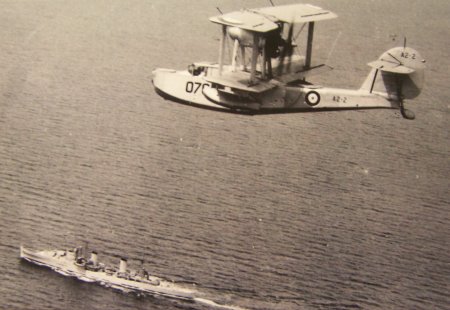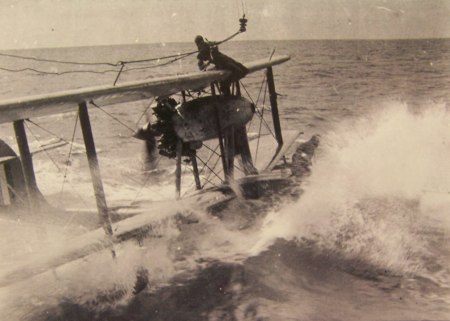David Mearns - Search Director, The Finding Sydney Foundation
We've had such a lousy string of luck since the start of this search it was about time that things started to go our way. An enormous amount of effort by the Williamson & Associates technicians, in particular Carter Le, has been put in to get us up and running again. So we were all greatly relieved when the SM30 sonar was deployed in the early hours of the morning and the first images revealed the search was back on track. There is still far more seabed geology in the southern third of our search box to my liking (and I am a trained marine geologist!) and the technical gremlins haven't completely left us, but we are searching today and that's all that counts.
At one point in the current trackline the sonar images started to look very much like the kind of debris field I am expecting to see associated with Kormoran's wreck. As the SM30 sonar updates only once every 4 seconds (ping rate) the images scroll down our screens at the pace of a snail so it can take up to 30 minutes before a feature reveals itself as either geology or a bona fide target. The expectation and excitement in the room rises to the point it is palpable while the images are studied and analysed very carefully. In this case it was more seabed geology but our senses are being sharpened for the real thing.
The trough I wrote about yesterday is still sitting on the coast of WA and doesn't look set to move east until Thursday. Meanwhile the winds and swell are still high but we are in a following sea today so the ride is comfortable. I have included a photograph of the navigation screen the helmsman uses to keep the Geosounder on track, which not only shows how well he is doing staying within our 25 metre guide lines but how he is doing it by "crabbing" down the line with the ship at a constant 15 degree angle to starboard.

Above Photograph - Navigation Screen showing the SV Geosounder "grabbing" down the line
Glenys McDonald - Director, The Finding Sydney Foundation (Observer)
The crew of MV Geosounder come from all parts of the globe. Their usual work routine is five weeks at sea, followed by five weeks at home, and they thrive on this type of existence. I have come to look forward to my evening chats where we do a fair amount of philosophising about the “good old days” when we were young.
The crew from Williamson’s and Associates are infectiously happy. They work as a great team, either deploying or recovering the fish in some very interesting sea conditions at all hours of the day or night, and then spend countless hours either monitoring screens or with the sonar under maintenance. My room mate Kelly is on her first deployment doing this type of work and I am in awe seeing her out there on the back deck doing her job alongside some big strapping men.
It gives me great comfort on this trip to have the combined wealth of experience of Art Wright of Williamson’s and David Mearns on board. This is their day job and they do it professionally and without fuss. John Perryman is keeping us in high spirits with some absolutely amusing stories of life at sea, and anecdotes from the history of our Navy. One of the hardest working groups on board are the three Electric Pictures crew who are everywhere – back deck, survey room, they even catch you having a nap on deck.

Above Photograph - Blair Cliffe, SV Geosounder's Master

Above Photograph - Kelly Curtis, one of Williamson & Associates' sonar operators

Above Photograph - Ulle, the cinematographer catching Glenys cat-napping
John Perryman - Senior Navy Historian (Observer)
Today was by far a much more positive and productive day. With the SM30 back in the water in the early hours of the morning we were soon heading into the southern end of our search box. It did not take us long to start picking up good paints of geological features in some areas while in other areas the sea bed appeared featureless. This was certainly a morale boosting victory following the testing times of the previous few days and it feels good to be back in our search box with our eyes fixed on our various monitors and sensors.
Historical Anecdote: The Australian modified Leander class cruisers, Sydney, Perth and Hobart each carried amphibious aircraft for the purpose of reconnaissance, anti-submarine work and gunnery spotting.
At the time of her loss, Sydney was carrying a Walrus aircraft mounted on a 53 foot long catapult located between her two funnels. To launch the aircraft the catapult was rotated so that it pointed to seaward. From this position the aircraft would then be hurled into the air and take flight. It could also be lowered over the side of the ship by a crane for water take offs if necessary. This crane was also used to recover the aircraft from the water on completion of a sortie. This was often a difficult evolution in choppy seas as can be seen in the accompanying photograph.
At the time that Sydney was lost, six members of the Royal Australian Air Force were serving in Sydney as members of her ship's company. They were responsible for the maintenance and operation of her Walrus aircraft.

Above Photograph - Sydney's amphibious aircraft flys over the famous cruiser

Above Photograph - The recovery of Sydney's aircraft could often be a difficult evolution.
IMPORTANT NOTICE: The Material (including photographs) available in the "Press Room" section of this Website may be used/reproduced unaltered by your organisation (unless stated otherwise within the content description) subject to the terms and conditions set out in the Legal Section AND any Material (including photographs) which you use/reproduce must credit the source as "The Finding Sydney Foundation" and, as an option, you may also link the source statement with the website address http://www.findingsydney.com/.